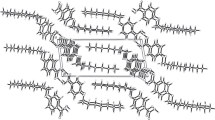Abstract
The crystal structure of 4-hexylbenzoic acid C6H13-C6H4-COOH, which forms a nematic mesophase upon melting, is determined. The crystal contains three crystallographically independent molecules. Their molecular skeletons are made up of two almost planar fragments: a benzene ring, π-conjugated with the carboxyl group and a planar zigzag aliphatic fragment. One of the independent molecules forms centrosymmetric dimers via pairs of hydrogen bonds between carboxyl groups, whereas the two others are linked via hydrogen bonds. The dimers in the crystal are packed into pseudostacks with a pronounced nonparallel arrangement of conjugated fragments. There is no good mutual projecting of benzene rings in the stacks, which corresponds to efficient π-stacking interaction. The graph describing the mesophase of this compound contains only one structure-forming element (a hydrogen bond) and corresponds to the nematic mesophase.
Similar content being viewed by others
References
S. M. Pestov, Physical Properties of Liquid Crystals / Landolt-Börnstein.Numerical Data and Functional Relationship in Science and Technology. New Series (Springer, Berlin, 2003), Vol. VIII/5 A.
L. G. Kuz’mina, N. S. Kucherepa, S. M. Pestov, et al., Kristallografiya 54(5), 908 (2009) [Crystallogr. Rep. 54 (5), 862 (2009)].
J.-M. Lehn, Supramolecular Chemistry. Concepts and Perspectives (Wiley-VCH, Weinheim, 1998).
F. Vögtle, Supramolecular Chemistry. An Introduction (Wiley, Chichester, 1991).
Comprehensive Supramolecular. Chemistry, Ed. by J.-M. Lehn and J. L. Atwood (Pergamon, Oxford, 1996), Vol. 1–11.
P. Hobza and R. Zahradnik, Intermolecular Complexes: the Role of van der Waals Systems in Physical Chemistry and in the Biodisciplines (Academia, Praga, 1988).
Intermolecular Interactions: from Diatomics to Biopolimers, Ed. by B. Pullman (Wiley, Chichester, 1978).
P. Schuster, Angew. Chem. Int. Ed. 20, 546 (1981).
K. Müller-Dethlef and P. Hobza, Chem. Rev. 100, 143 (2000).
S. K. Burley and G. A. Petsko, J. Am. Chem. Soc. 108, 7995 (1986).
P. Hobza, H. L. Selzle, and E. W. Schlag, Chem. Rev. 94, 1767 (1994).
P. Hobza, H. L. Selzle, and E. W. Schlag, J. Phys. Chem. 100, 18790 (1996).
R. S. Mulliken and W. B. Person, Molecular Complexes: A Lecture and Reprint Volume (Wiley, New York, 1969).
C. Janiak, J. Chem. Soc. Dalton Trans., 3885 (2000).
SAINT. Version 6.02A (Bruker AXS, Madison, WI, 2001).
SHELXTL-Plus. Version 5.10 (Bruker AXS, Madison, WI, 1997).
A. J. Blake, I. A. Fallis, S. Parsons, et al., Acta Crystallogr. C 51, 2666 (1995).
N. K. Lokanath, M. A. Sridhar, D. Revannasiddaiah, and J. S. Prasad, Liq. Cryst. 27, 767 (2000).
J. M. Seddon, Handbook of Liquid Crystals, Ed. by D. Demus et al. (Wiley, Weinheim, 1998), p. 635.
A. N. Kochetov, L. G. Kuz’mina, A. V. Churakov, et al., Kristallografiya 51(1), 59 (2006) [Crystallogr. Rep. 51 (1), 53 (2006)].
R. F. Bryan and P. Hartley, Mol. Cryst. Liq. Cryst. 62, 259 (1980).
R. F. Bryan and L. Fallon, J. Chem. Soc. Perkin Trans. 2 1175 (1975).
F. H. Allen and W. D. S. Motherwell, Acta Crystallogr. B 58, 407 (2002).
P. Gilli, V. Bertolasi, V. Ferretti, and G. Gilli, J. Am. Chem. Soc. 122, 10405 (2000).
V. Bertolasi, P. Gilli, V. Ferreti, and G. Gilli, Acta Crystallogr. B 54, 50 (1998).
Y. Mo, J. Mol. Model. 12, 665 (2006).
R. Viswanathan, A. Asensio, and J. J. Dannenberg, J. Phys. Chem. A 108, 9205 (2004).
A. Mohajeri, J. Mol. Struct.: THEOCHEM 678, 201 (2004).
R. W. Gora, S. J. Grabowski, and J. Leszczynski, J. Phys. Chem. A 109, 6397 (2005).
T. Steiner, Angew. Chem. Int. Ed. 41, 48 (2002).
V. Vill, Liqcryst 4.7—Database of Liquid Crystalline Compounds (LCI, Hamburg, 2008); www.liqcryst.chemie.uni-hamburg.de.
Author information
Authors and Affiliations
Corresponding author
Additional information
Original Russian Text © L.G. Kuz’mina, S.M. Pestov, A.N. Kochetov, A.V. Churakov, E.Kh. Lermontova, 2010, published in Kristallografiya, 2010, Vol. 55, No. 5, pp. 835–841.
Rights and permissions
About this article
Cite this article
Kuz’mina, L.G., Pestov, S.M., Kochetov, A.N. et al. Molecular and crystal structure of 4-hexylbenzoic acid: Design of the mesophase. Crystallogr. Rep. 55, 786–792 (2010). https://doi.org/10.1134/S1063774510050111
Received:
Published:
Issue Date:
DOI: https://doi.org/10.1134/S1063774510050111




